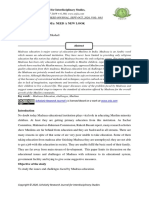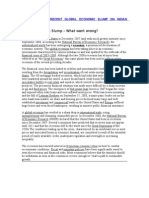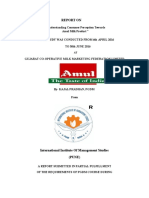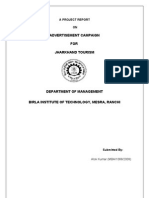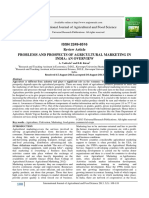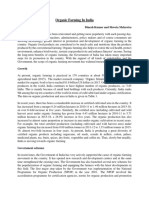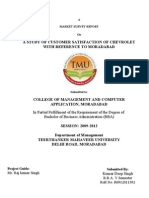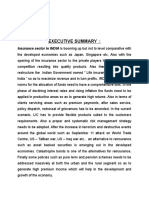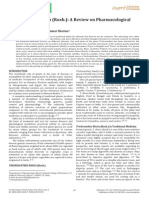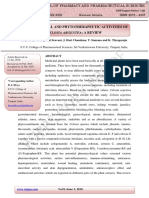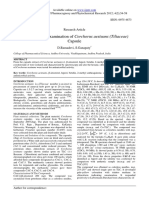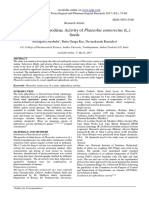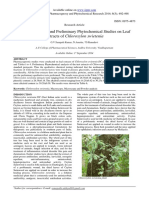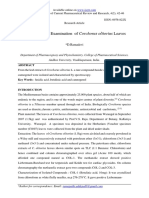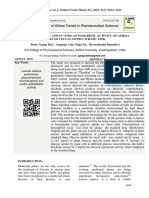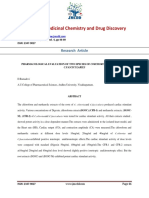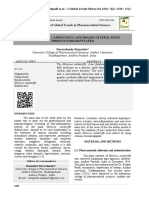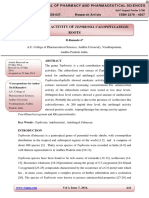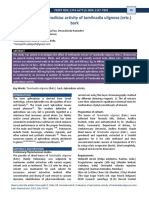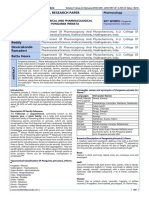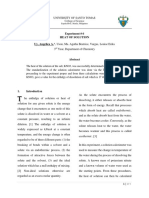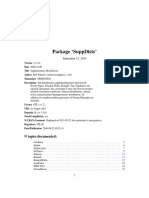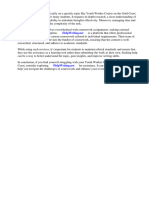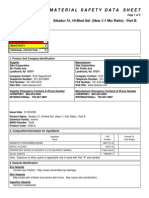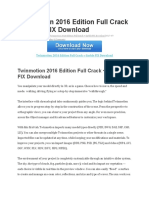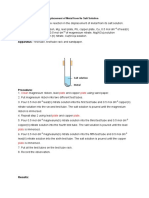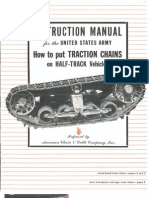Professional Documents
Culture Documents
Phytochemical and Pharmacological Studies On Wrightia Tinctoria
Uploaded by
Dr. Ramadevi DevarakondaOriginal Title
Copyright
Available Formats
Share this document
Did you find this document useful?
Is this content inappropriate?
Report this DocumentCopyright:
Available Formats
Phytochemical and Pharmacological Studies On Wrightia Tinctoria
Uploaded by
Dr. Ramadevi DevarakondaCopyright:
Available Formats
WORLD JOURNAL OF PHARMACY AND PHARMACEUTICAL SCIENCES
Ganga et al. World Journal of Pharmacy and Pharmaceutical Sciences
SJIF Impact Factor 7.421
Volume 7, Issue 4, 562-585 Review Article ISSN 2278 – 4357
PHYTOCHEMICAL AND PHARMACOLOGICAL STUDIES ON
WRIGHTIA TINCTORIA
Battu Ganga Rao*, Dodda L. N. Rajeswari, Devarakonda Ramadevi and Battu Heera
A.U College of Pharmaceutical Sciences, Andhra University, Visakhapatnam, India.
Article Received on ABSTRACT
09 Feb. 2018, Plants are being used from so many years to treat various diseases.
Revised on 01 March 2018,
Accepted on 22 March 2018, Wrightia tinctoria is a small deciduous tree belonging to the family
DOI: 10.20959/wjpps20184-11336 Apocayanaceae. It is distributed in India, Australia, Myanmar, Nepal,
and Timor, Vietnam. Within India, it is found in most of the peninsular
*Corresponding Author and central India except northern and north-eastern states.
Battu Ganga Rao Traditionally, the plant is used to treat seizures, wounds, jaundice,
A.U College of
leukaemia, gynaecological disorders, toothache, headache, dandruff,
Pharmaceutical Sciences,
diarrhoea and skin disorders like psoriasis, eczema, scabies etc. The
Andhra University,
Visakhapatnam, India. phytochemical studies have shown that the presence of alkaloids,
triterpenoids, steroids, flavonoids, lipids and carbohydrates.
W.tinctoria showed wide spectrum of pharmacological activities on anti-microbial, anti-
psoriatic, anti-diarrhoeal, anti-helminthic, anti-oxidant, anti-cancer, anti-inflammatory
analgesic, anti-diabetic, diuretic, hepatoprotective and anti-ulcer properties.
KEYWORDS: Wrightia tinctoria, phytochemistry, pharmacological studies.
Abbreviations
WHO - World Health Organisation
MIC - Minimum Inhibitory Concentration
INTRODUCTION
Wrightia tinctoria is a small deciduous tree belonging to the family Apocyanaceae. It is
commonly known as pala indigo plant or dyer’s oleander plant. Wrightia tinctoria R.Br.[1]
have two subspecies. Those are Wrightia tinctoria sub species W. tinctoria and W. tinctoria
rothii. Which is distributed in India, Myanmar, Nepal, Timor, and Vietnam. Within India, it
is found in most of the peninsular and central India except the northern and north-eastern
www.wjpps.com Vol 7, Issue 4, 2018. 562
Ganga et al. World Journal of Pharmacy and Pharmaceutical Sciences
states. Nerium tinctorium hort. Ex sweet,[2] Nerium tinctorium Roxb. Wrightia lacianata
A.DC and Wrightia timorensis Miq. Are synonymous to Wrightia tinctoria sp. Tinctoria,[3],
Traditionally the plant is used to treat diarrhoea, toothache, headache, jaundice,
gynaecological disorders, piles, ringworm and other skin diseases, the germinated seed of
W.tinctoria in Chhattisgarh (India) is used to traditionally cure jaundice. In south India it is
commonly called as “jaundice alkaloids, triterpenoids, lipids, carbohydrates, steroids,
flavonoids. W. tinctoria showed that the wide hepatoprotective, anti-helminthic, anti-
diarrhoeal, anti-psoriatic, diuretic, anti-cancer, anti-ulcer, analgesic and anti-oxidant
properties. In ayurvedic system the principle of drug action of W.tinctoria is described as
titka, kashaya, rooksha, sita and katu. Traditionally, the oil obtained by soaking W.tinctoria
leaves in coconut oil is used for treating psoriasis. Leaves when chewed alone or with salt
gives relief to toothache and its young stem is used as brush.[6] During headache leaf and stem
bark pastes are applied on the forehead or administered orally.[7] Stem bark paste mixed with
half cup of water is administered twice a day for 2 days for relief from abdominal pain.[7]
W.tinctoria (leaf, bark and seed) is also reported to have aphrodisiac potential and anti-
pyretic activity.[8] The plant is traditionally used to cure breast cancer.[9]
Description of family Apocynaceae[10,11]
Apocynaceae is a family of flowering plants of the gentian order (Gentianales), which
includes more than 415 genera and about 4600 species of trees, shrubs, herbs, stem
succulents and vines. Commonly called the dogbane family.[10] after the American plant
known as the dogbane, Apocynum cannabinum.[11] Members of this family are native to
European, Asian, African, Australian, and American tropics or subtropics, with some
temperate members. The family Asclepiadaceae (not known as Asclepiadoideae) is
considered a subfamily of Apocynaceae. Many of these plants have milky latex, and many
species are poisonous if ingested. They have smooth leaf margins and flowers in clusters
(rarely solitary).[12]
Synonym
Allamanda verticillate Desf.
Alstonia oleandrifolia Lodd.
Nerium Jaspedium Span. Invalid
Cerium tinctorium Sweet Illegitimate
Cerium tinctorium Roxb.
www.wjpps.com Vol 7, Issue 4, 2018. 563
Ganga et al. World Journal of Pharmacy and Pharmaceutical Sciences
Wrightia lacinata A.DC
Wrightia timorensia Miq.
Wrightia tinctoria subsp. tinctoria
Taxonomical classification[4]
Kingdom : Plantae, Angiosperms, Eudicots, Asterids
Order : Gentianales
Family : Apocyanaceae
Genus : Wrightia
Species : tinctoria
Vernacular names[5]
Telugu : Akupala, Amkudu, Chittankudu, Dodda pala chettu, Jedda pala chettu.
Hindi : Indrajava
Sanskrit : Svetakuja, Madhuindrajava, Hayamoraka
Marathi : Gode indrajava
Tamil : Erukkalam, Nilambalai
Kannada : Veppale
Malayalam : Ayyapala, Dantappala
Urdu : Indearjao shireen
Botanical description
Wrightia tinctoria is an ever green tree, which is a medium sized tree and it produces milky
white latex.
Wrightia tinctoria.
www.wjpps.com Vol 7, Issue 4, 2018. 564
Ganga et al. World Journal of Pharmacy and Pharmaceutical Sciences
Leaves: Leaves are simple with opposite leaf arrangement, petiolate, glands axillary and
Glabrous ovate, obtusely acuminate and are 10-20 cm long and 5cm width. Sometimes
pubescent beneath. Leaf stalks are very short.
Bark: Bark is smooth and yellowish-brown coloured and about 10 mm thick Producing
Milky-white latex.
Inflorescence: Inflorescence is terminal and flowers are white, bisexual, actinomorphic and
hypogynous. Appear in India from March to May, peaking flowers appears flowers appear in
corymb-like cymes, 5-15 cm across, at the end of branches. Flowers have oblong petals
which are rounded at the tip, and are similar to the Flowers of frangipani.[12]
Fruits: Fruiting is in august and fruit is cylindrical, blackish-green speckled with white long
horn like and united at the tip.
Seeds:[12] The seeds are brown and flat with bunch of white hairs at chalazal end.[13] Seed
dispersal is by Wind.
Pollination:[12] Pollination is entemophilous without any direct contact of the biotic factor
With pollen or stigma.[8,10]
Fruits: Fruits are mericarpous in origin, dark green in colour and have paired Pendulous
follicles joined at the tips which may be long upto 50 cm.
Propogation: Propogation can be done by seeds and stem cuttings.[14,15] The wood of
W.tinctoria has uniformly distributed grains and is light in weight. It grows in wide range of
soil types and are found to grow as undergrowth in forest and under various plantations like
oil plantation etc.[16] The karyotype of W.tinctoria (intraspecific polyploidy, disomy) is
2n=20, 22.[17,18] They are found in India, Myanmar, Australia, Tropical Africa, Nepal and
China.[19]
Traditional uses
Bark and seeds are used to treat flatulence.
Root bark extract is used orally as an antidote for snakebite.
Powder of the bark is used for treatment of kidney stones.
www.wjpps.com Vol 7, Issue 4, 2018. 565
Ganga et al. World Journal of Pharmacy and Pharmaceutical Sciences
The plant is used in making hair oils as it has anti-dandruff and anti-inflammatory
properties.
Wrightia tinctoria is the best medicine for Diarrhoea and blood pressure.
It is used to cure piles by mixing sunthi with decoction of bark of the plant.
The bark of the plant mixed with cow’s urine and applied on skin, turns to be very
effective.
Fresh juice of the bark is mixed with cow milk and used to cure urine problems.
It is used in the treatment of Rheumatoid Arthritis and osteoarthritis.
It is also a good remedy for fever, toothache, constipation and stomach ache.
The milk of this plant is used to treat tooth gum problems.
Species of Wrightia[20]
Wrightia angustifolia
Wrightia annamensia
Wrightia antidysentrica
Wrightia arborea
Wrightia candollei
Wrightia coccinea
Wrightia collettii
Wrightia cunninghamii
Wrightia demartiniana
Wrightia dolichocarpa
Wrightia dubia
Wrightia flavirosea
Wrightia hanleyi
Wrightia indica
Wrightia karaketii
Wrightia laevis
Wrightia lanceolata
Wrightia lecomtei
Wrightia natalensis
Wrightia novobritambica
Wrightia palawanensis
www.wjpps.com Vol 7, Issue 4, 2018. 566
Ganga et al. World Journal of Pharmacy and Pharmaceutical Sciences
Wrightia poomae
Wrightia puberula
Wrightia pubenscens
Wrightia religiosa
Wrightia saligna
Wrightia siamensis
Wrightia sikkimensis
Wrightia siritiae
Wrightia tinctoria
Wrightia tokiae
Wrightia viridifolia
Past phytochemical studies
S.no Plant part used Compounds isolated Reference
Lupeol, α- and β- amyrin, Indigotin,
Indirubin, tryptanthrin, Isatin, Rutin, β-
[61,63,66,23,24,26,40,51]
1. Leaves sitosterol, Triacontanol, Myristic acid,
Palmitoleic acid, Palmetic acid, Stearic
acid, Behenic acid, Arachidic acid.
Hexadecanoic acid, 15-methyl 2-mercapto-
[41,66,67]
2. Flowers propanoic acid, Pentadecanoic acid, 3-
methyl-3-butanoic acid, Disilanone.
[61,62,63,60,66]
3. Stem Lupeol, Stigmasterol, campesterol
[61,63,66,67]
4. Bark Lupeol, α- and β-amyrin
Lupeol, Chlorogenic acid, Dihydrocanaric
acid, Glycerol, Erythritol, Thritol, D-
galactose, D-mannose, 14 α-methyl
zymosterol, Desmosterol, Clerosterol, 24-
methylene-25-methyl cholesterol, 24-
[61, 62, 63,66, 59, 41,64]
5. Seeds dehydropollinastanol, 24-methylcholesterol,
24-methylene cholesterol, 24-ethyl
cholesterol, 24 ethyl 22 E-
dehydrocholesterol, Isofucosterol,
cholesterol, Palmetic acid, stearic acid,
Behenic acid, Arachidic acid
α- and β-amyrin, Lupeol, Ursolic acid,
Mature [61, 62, 63-66]
6. Oleanolic acid, Isoricinolic acid, β-
seedpods
sitosterol.
Immature α- and β-amyrin, Cycloartenone, [61, 62, 63,66]
7.
seedpods Cycloeucalenol, Wrightial, β-sitosterol
www.wjpps.com Vol 7, Issue 4, 2018. 567
Ganga et al. World Journal of Pharmacy and Pharmaceutical Sciences
Some isolated compounds
Cycloartenone Cycloeucalenol
Indirubin Indigotin
α-Amyrin β-amyrin
www.wjpps.com Vol 7, Issue 4, 2018. 568
Ganga et al. World Journal of Pharmacy and Pharmaceutical Sciences
Β-sitosterol Stigmasterol
Oleanolic acid Myristic acid
Palmetic acid Isatin
www.wjpps.com Vol 7, Issue 4, 2018. 569
Ganga et al. World Journal of Pharmacy and Pharmaceutical Sciences
Rutin Tryptanthrin
Lupeol Wrightial
Ursolic acid Chlorogenic acid
www.wjpps.com Vol 7, Issue 4, 2018. 570
Ganga et al. World Journal of Pharmacy and Pharmaceutical Sciences
Glycerol Erythritol
Thritol D-Galactose
D-Mannose Campesterol
www.wjpps.com Vol 7, Issue 4, 2018. 571
Ganga et al. World Journal of Pharmacy and Pharmaceutical Sciences
Desmosterol Clerosterol
Cholesterol Triacontanol
Palmitoleic acid Stearic acid
www.wjpps.com Vol 7, Issue 4, 2018. 572
Ganga et al. World Journal of Pharmacy and Pharmaceutical Sciences
Behenic acid Arachidic acid
Hexadecanoic acid
Phytochemistry
Extraction of W.tinctoria on Various parts of had been extracted using various solvents in
different succession. Therefore, the biochemical groups detected in the extracts. Alkaloidal
fraction of the bark was separated using TLC. The leaf extracts produced negative results for
alkaloids, fixed oils, coumarins, gums and resins.[26] In another experiment,[21] similar
phytochemical work was carried out in W.tinctoria bark where triterpenes were not identified
in ethyl acetate, acetone and methanol fractions, alkaloids were found to be present in ethanol
fraction and fixed oils reported in petroleum ether fraction. Glycoside was found to be absent
in ethanol extract of W.tinctoria bark,[27] Similar biochemical identification of the functional
groups have been carried out in different studies. The compounds identified in W.tinctoria
belongs to terpenes, flavonoids, sterols, polysaccharides and lipids. Along with the
www.wjpps.com Vol 7, Issue 4, 2018. 573
Ganga et al. World Journal of Pharmacy and Pharmaceutical Sciences
phytocompounds, W.tinctoria is also found to contain important enzyme. Proteases are
commercially important class of enzymes and the hydrolytic property of the enzyme is
exploited in various biotechnological processes. A serine protease, Wrightin, has been
isolated from the latex of Wrightia tinctoria. The stable thermodynamic properties of
Wrightin make it an economical source of protease for commercial exploitation.[28] The plant
contains Wrightial, a triterpenoid chemical, along with Cycloartenone, Cycloeucalenol, β-
amyrin and β-sitosterol as phytocompounds.
Past pharmacological work
Anti-microbial activity
Various diseases caused by microbes are treated by available drugs. They treated the human
population by the resistance of microorganisms to the available drugs. Wrightia tinctoria is
used for skin disorders in different parts of the country.[32] The terpenoids and flavonoids of
W.tinctoria are found to have anti-microbial property against pathogenic bacteria, fungus,
virus and protozoans has been reviewed below:
Anti-bacterial activity
Activities against Staphylococcus, Salmonella, Pseudomonas, Klebsiella, Micrococcus sp.
and E.coli have been reported. Ranjani et al (2012) showed that Methanol and ethanol
extracts of W.tinctoria leaves were found to have strong inhibitory activity against
Staphylococcus, Bacillus species.[33,34,35] Kyade and vaikos (2011)[43] showed that the anti-
bacterial activity of Wt bark extract at 100 mg/ml was not very broad. Chloroform, acetone
and methanol extracts showed moderate activity against S.typhi, B.subtilis, B.megaterium,
E.coli, P.aeruginosa and M.luteus. None of the extracts showed activity against
K.Planticola.[43] The aqueous and methanol extract of W.tinctoria leaves showed potent anti-
bacterial activity in different studies.[44,45] Ethanol extract of W.tinctoria flower also showed
potent activity against both gram positive and gram negative bacteria.[41]
Anti-fungal activity
Pityrosporum ovale is a fungi belonging to the family Basidiomytes, which is causing major
cosmetic problem of dandruff. The active constituents in Wrightia tinctoria have shown
significant inhibition against P.ovale and C.albiccans.[42,43] The hexane extract of W.tinctoria
leaves was found to have very good anti-dermatophytic activity against Trichophyton and
Epidermophyton species.[38,44] The chloroform extract of W.tinctoria leaves showed anti-
www.wjpps.com Vol 7, Issue 4, 2018. 574
Ganga et al. World Journal of Pharmacy and Pharmaceutical Sciences
fungal activity against most of the dermatophytes with MIC in the range of 0.5-4 mg/ml.[44]
The ethanol extract of W.tinctoria leaves was found to inhibit a wide range of fungal genera
viz. Curvularia, Botrytis, Aspergillus was found to have highly significant inhibition against
dermatophytes with extract concentration upto 1000 ppm.[36] Methanol and aqueous extract of
W.tinctoria leaves also found to have effective against Curvularia sp.[39] indirubin is the
major phyto compound from chloroform extract of W.tinctoria leaves and was found to have
anti-fungal activity (MIC 6.25-50 µg/ml) against dermatophytes, non-dermatophytes and
yeast.[44] The aqueous extract of W.tinctoria leaves and seeds were ineffective against
Aspergillus, Mucor and dermatophytic species. Whereas methanol extract was moderately
active against Aspergillus and Mucor species.[40,45] Chloroform and methanol extract of
W.tinctoria woody stem were found to be effective against non-dermatophytic fungi.[37]
Anti-leishmanial activity/ Anti-plasmodial activity
An indole alkaloid of tryptanthrin is naturally found in W.tinctoria leaves had been found to
be active against Leishmania species and Plasmodium falsiparum.[46,47] Various tryptanthrin
derivatives are being used for the drug development against these protozoans.
Anti-viral activity
The methanol extract of the W.tinctoria leaves was found to be have anti-viral activity against
hepatitis C virus using Huh 5.2 cell line (a cell line with a persistent viral replication).[48] The
aqueous leaf extract having flavonoids, particularly isatin and its derivatives found to have
anti-HIV activity by inhibiting HIV-1 integrase enzyme during its 3’ processing and strand
tranfer with IC50 of 1.9 ± 0.5 µg/ml and 1.4 ± 0.3 µg/ml respectively.[49] Hence W.tinctoria
can also be used for the current menace, AIDS.
Anti-psoriatic activity
Psoriasis is an autoimmune disorder of skin that is characterized by skin redness, itching and
patchy looks. Traditionally, W.tinctoria is used to treat psoriasis, eczema, scabies etc. and
that was clinically proved.[7,53] Hydro-alcoholic extract of W.tinctoria was found to have anti-
psoriatic activity.[51,52] A formulation with trade name RegSor® contains Wrightia tinctoria
and Cocus nucifera as main components for the treatment of psoriasis.[54]
Anti-helminthic activity
Helminths are parasitic worms affecting human beings via contaminated food and water or
find their way into human body through soil. They dependent on their hosts for nutrition and
www.wjpps.com Vol 7, Issue 4, 2018. 575
Ganga et al. World Journal of Pharmacy and Pharmaceutical Sciences
making them weak and susceptible to other diseases or affect the organ where they placed. In
one of the study when compared to the chloroform extract of W.tinctoria leaves with the
standard drug of piperazine, the chloroform extract of W.tinctoria were found to be more
potent against the Pheretimaposthuma.[55] In another study, methanol and aqueous extracts of
W.tinctoria leaves showed comparable anti-helminthic activity.[56]
Anti-diarrhoeal activity
Ethanol extract of Wrightia tinctoria bark and steroidal alkaloid fraction derived from it were
found to have anti-diarrhoeal activity by showing its effect on prostaglandin inhibition and
decreasing intestinal propulsive / spasmodic movement.[35]
Anti-oxidant activity
Oxidative stress in various diseases causing the damage of cells and tissues. Anti-oxidants are
more important to combat these free radicals in our body. Ethanol extract of W.tinctoria bark
and flowers was found to be effective in reducing Fe3+ to Fe2+ and also have
superoxidebradical scavenging activity which makes it a potential anti-oxidant agent.[41,57,58]
Dihydrocanaric acid found in W.tinctoria is a powerful anti-oxidant agent. The hydro-
alcoholic extract of W.tinctoria leaves showed very good anti-oxidant activity in DPPH, H2O2
and nitric acid scavenging assays.[52]
Anti-cancer activity
The plant used for anti-cancer activity, must have the cytotoxicity activity. Brine shrimp
lethality bioassay is considered as standard assay to evaluating the toxicological profile. It is
used to evaluate the pharmacological profile of natural compounds. The ethanol (70%) and
methanol extract of W.tinctoria leaves exhibited LC50 of 471.604 µg/ml and 517.038 µg/ml
respectively. While aqueous, petroleum ether, dichloromethane, ethyl acetate and chloroform
extracts of leaves are non-toxic.[45]
W.tinctoria bark extracted with 90% ethyl alcohol was found to be effective against MCF-7
(human breast cancer cell line) but was only moderately active against HL-60 (human
leukemia cell). Flower extract of W.tinctoria showed toxicity by brine shrimp toxicity
bioassay where the LC50 value was found to be 3.544 µg/ml.[29] The W.tinctoria having the
active constituent of flavonoid shows the cytotoxic activity. Indirubin, (a flavonoid) is a
constituent of W.tinctoria is active against an anti-leukemia medicine in China.[47] This
W.tinctoria can be considered as a more potent anti-cancer plant.
www.wjpps.com Vol 7, Issue 4, 2018. 576
Ganga et al. World Journal of Pharmacy and Pharmaceutical Sciences
Anti-inflammatoty / immunomodulatory activity
The use of Wrightia to treat anti-arthritic/anti-inflammatory conditions had been reported in
different reviews.
Anti-inflammatory activity in W.tinctoria bark was first reported by Tharkar et al. in 2010[49]
where the aqueous, chloroform and methanol extracts were proposed to inhibit the kinin- and
prostaglandin- like mediators, and were also involved in the suppression of the proliferative
stages of inflammation at the dose of 200 mg/kg. Though the result was found to be
statistically significant, the level of inhibition was less as compared to the standard drug,
diclofenac. The petroleum ether and methanol extracts of the W.tinctoria woody stem at the
doses of 100, 200 and 400 mg/kg caused a significant inhibition on inflammation in the
carrageenan- and histamine- induced rat paw oedema which can be attributed to the presence
and synergistic action of flavonoids, steroids and triterpenoids.[59] The ethyl acetate and
aqueous fraction of W.tinctoria leaves showed significant anti-inflammatory activity.[30]
The bark of W.tinctoria was successively extracted with Petroleum ether, alcohol and
aqueous alcohol. The Petroleum ether and alcohol extracts showed certain
immunomodulatory activity by rat paw oedema test and macrophage clearance phagocytic
index. Whereas the aqueous alcohol extract didn’t possess any immunomodulatory
activity.[50] The W.tinctoria possess both immunomodulatory and anti-inflammatory activity.
Therefore, W.tinctoria may be a potential for skin problems at an earlier stage of infection.
CNS Activity
The methanol extract of W.tinctoria leaves showed modulatory role in the expression level of
serotonin, nor-epinephrine and dopamine in brain, which may be particularly useful to
combat anxiety and depression.[51] W.tinctoria had been explored for CNS activity in a study
by Bigoniya and Rana[21] and they found that the 70% ethanol extract of W.tinctoria bark had
no effect on CNS up to a concentration of 1000 mg/kg in albino rats. However, Isatin, one of
the compound isolated from W.tinctoria leaves, and its derivatives are known to possess anti-
convulsant activity.[52,53] Owing to its traditional usage for treating convulsions, more work
on W.tinctoria is required to understand the pharmacological activity of this plant in
connection to Central Nervous System.
www.wjpps.com Vol 7, Issue 4, 2018. 577
Ganga et al. World Journal of Pharmacy and Pharmaceutical Sciences
Anti-nociceptive/Anti-analgesic activity
Wrightia tinctoria bark was evaluated using acetic acid-induced writhing test, in which
methanol extract showed to have Anti-nociceptive activity comparable to acetyl salicyclic
acid. More work is needed to know about the active compounds responsible for the
activity.[20] The ethanol extract of bark showed Anti-nociceptive effect and moderate
analgesic effect against thermal and chemical stimuli but not mechanical stimulus, which
may be due to the presence of steroids.[21] The study also concluded that W.tinctoria didn’t
have any sedative effects. Ethyl acetate fraction of W.tinctoria leaves showed analgesic
activity and was found to be effective in inhibiting both centrally and peripherally acting pain
mechanisms.[30]
Anti-diabetic activity
Streptozotocin induced assay in albino Wister rats were used to analyze the anti-diabetic
activity of the plant. Chloroform extract of W.tinctoria leaves significantly reduced the blood
glucose level at the dose of 200 mg/kg and was comparable to the action of known drug,
glibenclamide.[45] W.tinctoria exhibited hypoglycemic activity at 250 mg/kg but the mode of
action is unknown,[54] Ashok Raj et al.[55] reported that the petroleum ether extract of
W.tinctoria leaves exhibited hypocholersterolemic and hypotriglyceridemic effects which is
possibly modulated via some unknown extra pancreatic mechanism and they concluded that
the petroleum ether leaf extract not only lowered the blood glucose level at 400 mg/kg but
also modulated the blood lipid abnormalities which is a secondary complication arising out of
diabetes thereby lowering the cardiovascular risk, thus may have significant role in
combating diabetes mellitus. Wrightia tinctoria bark was also found to possess alpha-
glycosidase inhibitory activity at 1500 µg/ml which can be further investigated for
controlling blood glucose level in diabetic patients.[43]
Diuretic activity
Aqueous and alcohol extracts of W.tinctoria leaves were found to be significantly and
comparably active in increasing the urinary water and electrolyte (Na+, Cl-, K+)
concentration when compared to standard drug furosemide, in an experiment done according
to the CPCSEA guidelines by sathianarayanan et al.[58] In another study also, the hydro-
alcohol extract of W.tinctoria bark was found to increase Na+ and Cl- ions, thus strongly
kaliuretic.[22] Therefore, W.tinctoria can be further explored for its diuretic potential for
management of hypertension, kidney disorders, heart problems etc.
www.wjpps.com Vol 7, Issue 4, 2018. 578
Ganga et al. World Journal of Pharmacy and Pharmaceutical Sciences
Wound healing
The petroleum ether and methanol extract showed significant wound healing properties,
which probably were due to increase in the collagen and fibrin content as determined by the
tensile strength of the resutured wound. This may be due to the anti-oxidant and anti-
inflammatory activity exerted due to the presence of terpenoids, steroids and flavonoids in the
plant extract.[44] Traditionally, the latex from W.tinctoria is used to stop bleeding.
Anti-ulcer activity
Hydrochloric acid extract of W.tinctoria bark at 1000 mg/ml was found to possess significant
antiulcer activity based on evaluating the factors relating to gastric juice, acidity level, protein
and carbohydrate content in gastric mucous substances.[45] The abdominal distress caused by
ulcer due to bacterial action and food habits is an important area of concern. However, more
work in W.tinctoria is required to gain insight into its efficacy against ulcer.
Activities done on different parts of Wrightia tinctoria
S.NO Plant part used Activity done Reference
Anti-bacterial activity,
Anti-viral activity,
Anti-fungal activity,
Anti-inflammatory activity,
Anti-nociceptive activity,
Anti-psoriatic activity,
Anti-helminthic activity, [33,34,39,40,44,46,47]
1. Leaves
Anti-convulsant activity,
Anti-HIV activity,
Anti-leishmanial activity,
Anti-oxidant activity,
Anti-tumor activity,
Anti-diabetic activity,
Diuretic activity.
Anti-oxidant activity,
Anti-bacterial activity,
Anti-fungal activity,
Anti-diabetic activity,
[31,37,38,49,52]
2. Bark Anti-diarrhoeal activity,
Anti-tumor activity,
Anti-nociceptive activity,
CNS activity,
Anti-inflammatory activity.
Anti-oxidant activity,
[41,57,58]
3. Flowers Anti-microbial activity,
Cytotoxic activity.
Anti-oxidant activity,
Anti-bacterial activity, [40,44,45]
4. Seeds
Anti-fungal activity,
Anti-diabetic activity.
www.wjpps.com Vol 7, Issue 4, 2018. 579
Ganga et al. World Journal of Pharmacy and Pharmaceutical Sciences
CONCLUSION
The extensive literature survey revealed that Wrightia tinctoria is an important medicinal
plant with diverse pharmacological and phytochemical spectrum. The plant shows the
presence of many chemical constituents like steroids, triterpenoids, Saponins, tannins,
phenols, flavonoids, glycosides, carbohydrates, alkaloids and polyphenols which are
responsible for the various pharmacological and medicinal properties like Anti-inflammatory
activity, Anti-microbial, Anti-oxidant, Anti-cancer, Anti-diabetic, Anti-psoriatic activity etc.
However, evaluation needs to be carried out on Wrightia tinctoria in order to explore the
concealed areas and their practical clinical applications, which can be used for the welfare of
the mankind.
ACKNOWLEDGEMENT
We are thankful to Prof. B. Ganga Rao sir and Dr. D. Ramadevi madam, Department of
Pharmacognosy and Phytochemistry, Andhra University College of Pharmaceutical Sciences,
Visakhapatnam, for permitting this research work and kindly support to my work.
Conflicts of interest
There are no conflicts of interest.
REFERENCE
1. Brown R, Wrightia tinctoria R. Br., Mem Wern Nat Hist Soc., 1810; 1: 74-75.
2. Nasir E, Ali SI (Eds), Fl. Pakistan, Univ. of Karachi, Karachi, 1980-2005.
3. Ngan PT, A revision of the genus Wrightia (Apocyanaceae). Ann Miss Bot Gard., 1965;
52: 114–175.
4. Joshi SG, Medicinal plants (Oxford & IBH publishing Co. Pvt. Ltd., New Delhi), 2000;
51-52.
5. “The Plant List Version 1.1”. The plantlist.org, 2013. Retrieved 21 April 2016.
6. Ganesan S. Traditional oral care medicinal plants survey of Tamilnadu. Natural Product
Radiance, 2008; 7(20): 166-172.
7. Rao JK, Seetharami Reddi TVV and Kumar OA. Ethanobotany of stem bark of certain
plants of Visakha patnam district, Andhra Pradesh. Current Botany, 2011; 2(5): 01-06.
8. Singh B, Gupta V, Bansal P, Singh R and Kumar D. Pharmacological potential of plant
used as aphrodisiacs. Int J Pharm Sci Rev and Res., 2010; 5(1): 104-113.
9. Nagarani B, Debnath S, Kumar S C, Bhattacharjee C and Kumar GG. A review: herbs
used as anticancer agents. IRJP, 2011; 2(1): 20-24.
www.wjpps.com Vol 7, Issue 4, 2018. 580
Ganga et al. World Journal of Pharmacy and Pharmaceutical Sciences
10. Raju AJS, Zafar R and Rao SP. Floral device for obligate selfing by remote insect activity
and anemochory in Wrightia tinctoria (Roxb.) R.Br. (Apocynaceae), Curr Sci., 2005;
88(9): 1378-1380.
11. Brown R, Wrightia, Flora of China, 1995; 16: 174–175.
12. Reddi CS, Reddi EUB and Reddi MS. A novel mechanism of pollination in Wrightia
tinctoria R.Br. Curr Sci., 1979; 48(16): 746-747.
13. Rao PS, Maheswar Rao G and Satyanarayana VVV. Rooting of stem cuttings of Wrightia
tinctoria (Roxb.) R.Br: An important medicinal plant. Indian Forester., 1999; 125(4):
427-428.
14. Suresh DR, Hegde GV and Ganesh KB, Vegetative propagation of Wrightia tinctoria
R.Br. - An important multipurpose tree. Indian Forester, 2004; 130(8): 950-952.
15. Sarada S, Nair GS and Reghunath BR. Quantification of medicinally valuable weeds in
oil palm plantations of Kerala. Journal of Tropical Agriculture, 2002; 40: 19-26.
16. Gill BS, Singhal VK, and Bedi YS and Bir SS. Cytological evolution in the woody taxa
of Pachmarhi Hills. J Cytol Genet., 1990; 25: 308–320.
17. Khan K, Sharma SK, Ramarao S and Purohit SD, Karyomorphological Studies in
Wrightia tomentosa and W. tinctoria, Multipurpose Tree Species of Aravallis in South
East Rajasthan. Cytologia, 2011; 76(2): 125-128.
18. Orwa C, Mutua A, Kindt R, Jamnadass R and Anthony S, Agroforestree Database: a tree
reference and selection guide version 4.0 (World Agroforestry Centre, Kenya), 2009.
19. Sethi PD. Separation of alkaloidal constituents of Wrightia tinctoria by TLC. Planta med.,
1970; 18(1): 26-29.
20. Reddy YSR, Venkatesh S, Ravichandran T, Murugan V and Suresh B. Antinociceptive
activity of Wrightia tinctoria bark. Fitoterapia, 2002; 73: 421-423.
21. Bigoniya P and Rana AC. Absence of central activity in Wrightia tinctoria bark ethanolic
extract. J Pharm Neg Res., 2010; 1(2): 51-54.
22. Tomar R, Kumar R and Jagannadham MV. A stable serine protease, Wrightin, from the
latex of the plant Wrightia tinctoria (Roxb.) R. Br.: purification and biochemical
properties. J Agri Food Chem., 2008; 56: 1479-1487.
23. Kannan P, Shanmugavadivu B, Petchiammal C and Hopper W. In vitro antimicrobial
activity of Wrightia tinctoria leaf extracts against skin microorganisms. Acta botanica
Hungarica, 2006; 48(3-4): 323-329.
www.wjpps.com Vol 7, Issue 4, 2018. 581
Ganga et al. World Journal of Pharmacy and Pharmaceutical Sciences
24. Yogesh M and Mohan JSS. Screening of plants for their potential antibacterial activity
against Staphylococcus and Salmonella spp. Natural Product Radiance., 2007; 6(4):
301305.
25. Ranjani S, Deepa M, Kalaivani K and Sheela P. Antibacterial and antifungal screening of
ethanol leaf extract of Wrightia tinctoria against some pathogenic microorganisms. Drug
Invention Today, 2012; 4(5): 365-367.
26. Kyade MS and Vaikos NP. Comparative phytochemical and antibacterial studies on the
bark of Wrightia tinctoria and Wrightia arborea. Int J Pharma Bio Sci., 2011; 2(1):
176181.
27. Ashokkumar P, Rajkumar and Kanimozhi M. Phytochemical screening and antimicrobial
activity from five Indian medicinal plants against human pathogens. Middle-East Journal
of Scientific Research, 2010; 5(6): 477-482.
28. Sridhar S, Kamalakannan P, Elamathi R, Deepa T and Kavitha R. Studies on
antimicrobial activity, physio-chemical and phytochemical analysis of Wrightia tinctoria
R. Br. IJPRD., 2011; 3(8): 139-144.
29. Ramalakshmi S, Edayadulla N, Ramesh P and Muthuchelian K. Investigation on
cytotoxic, antioxidant, antimicrobial and volatile profile of Wrightia tinctoria (Roxb.) R.
Br. Flower used in Indian medicine. APJTD, 2012; D68-S75.
30. Krishnamurthy JR, Ranganathan S, Gokul Shankar S and Ranjith MS. Dano: A herbal
solution for dandruff. African Journal of Biotechnology, 2006; 5(10): 960-962.
31. Journal of Ethnopharmacology. 2010; 132: 349-354.
32. Vonshak A, Barazani O, Sathiyamoorthy P, Shalev R, Vardy D et al. Screening south
Indian medicinal plants for antifungal activity against cutaneous pathogens, Phytother
Res., 2003; 17: 1123–1125.
33. Frederich M, Tits M and Angenot L. Potential antimalarial activity of indole alkaloids.
Transactions of the royal society of tropical medicine and hygiene, 2008; 102: 11-19.
34. Sathyanarayanan S, Selvam P, Jose A, George RM, Revikumar KG et al. Preliminary
phytochemical screening and study of antiviral activity and cytotoxicity of Wrightia
tinctoria. Int J Chem Sci., 2009; 7(1): 1-5.
35. Periyasamy S, Kasthuraiah M and Yves P. Studies of HIV-1 Integrase Inhibitory Activity
of Wrightia tinctoria. Antiviral Research, 2010; 86(1): A28.
36. Fadl TA and Bin-Jubair FAS. Anti-tubercular activity of isatin derivatives. Int J Res
Pharm Sci., 2010; 1(2): 113-126.
www.wjpps.com Vol 7, Issue 4, 2018. 582
Ganga et al. World Journal of Pharmacy and Pharmaceutical Sciences
37. Krishnamurthy JR, Kalaimani S and Veluchamy G. Clinical study of vetpalai (Wrightia
tinctoria L.) oil in the treatment of kalanjagapadai (psoriasis). Journal of Research in
Ayurveda and Siddha, 1981; 2(1): 58-66.
38. Dhanabal S P, Anand Raj B, Muruganantham N, Praveen T K and Raghu P S. Screening
of Wrightia tinctoria leaves for anti-psoriatic activity. Hygeia J D Med., 2012; 4(1):
73-78.
39. Gopi Radha AK. Siddha herbs exclusively used in skin diseases (NISCAIR, New Delhi).
2006.
40. Reddy NBB. Clinical and histopathological evaluation of the effect of Wrightia tinctoria
formulation (RegSoR®) on Psoriasis vulgaris. US Dermatology Review, 2007; 6-8.
41. Shruthi A, Latha KP, Vagdevi HM, Vaidya VP, Pushpa B et al. In vitro anthelmintic
activity of leaves extract of Wrightia tinctoria. Int J Chemtech Res., 2010; 2(4): 2043-45.
42. Tare HL, Gore MS, Deore SR and Bidkar JS. Comparative hemintholytic potential of
extracts obtained from Cymbopogon citratus and Wrightia tinctoria leaves. Int J Pharma
and Bio Sci., 2011; 2(1): 321-327.
43. Jain R and Jain SK. Total phenolic contents and antioxidant activities of some selected
anticancer medicinal plants from Chhattisgarh State, India. Pharmacology online, 2011;
2: 755-762.
44. Kumar LD, Rao KNV, Madhavi B, Kumar SD and Banji D. Anti-oxidation activity of
Wrightia tinctoria Roxb bark and Schrebera swietenoides Roxb bark extract. J of Phar
Res., 2011; 4(2): 396-397.
45. Ghosh A, Sarkar A, Mitra P, Banerji A, Banerji J et al. Crystal structure and DFT
calculations of 3, 4-seco-lup-20(29)-en-3-oic acid isolated from Wrightia tinctoria:
Stacking of supramolecular dimmers in the crystal lattice. Journal of Molecular Structure,
2010; 980: 7-12.
46. Devi SL and Divakar MC, Toxicological profiles of the leaf extracts of Wrightia arborea
and Wrightia tinctoria. Hygeia J D Med., 2010; 2(1): 46-53.
47. Jain R and Jain SK. Screening of in vitro cytotoxic activity of some medicinal plants used
traditionally to treat cancer in Chhattisgarh state, India. Asian Pacific Journal of Tropical
Biomedicine, 2011; S147-S150.
48. Hoessel R, Leclerc S, Endicott JA, Nobel MEM, Lawrie A et al. Indirubin, the active
constituent of a Chinese anti-leukaemia medicine, inhibits cyclin-dependent kinases.
Nature cell biology, 1999; 1: 60-67.
www.wjpps.com Vol 7, Issue 4, 2018. 583
Ganga et al. World Journal of Pharmacy and Pharmaceutical Sciences
49. Shah BN, Nayak BS, Seth AK, Jalapure SS, Patel KN et al. Search for medicinal plants as
a source of anti-inflammatory and anti-arthritic agents – a review. Pharmacognosy
Magazine, 2006; 2(6): 77-86.
50. Tharkar PR, Tatiya AU, Surana SJ, Bhajipale NS and Deore SR. Anti-inflammatory study
of Wrightia tinctoria R. Br. Stem bark in experimental animal models. Int J PharmTech
Res., 2010; 2(4): 2434-2437.
51. Thabah P, Murugananthan G, Joshi NC, Nandakumar K, Lakshman K et al.
Immunomodulatory activities of Wrightia tinctoria (Roxb.) R. Br. Bark extracts.
Pharmacologyonline, 2009; 3: 663-669.
52. Muruganandam AV, Jaiswala K, Ghosal S and Bhattachary SK. Effect of Wrightia
tinctoria on the brain monoamines and metabolites in rats. Biogenic Amines, 1998; 14(6):
655-665.
53. Muruganadam AV, Bhattacharya SK and Ghosal S. Indole and flavonoid constituents of
Wrightia tinctoria and W. tomentosa and W. Coccinea. Ind J Chem., 2000; 39B(2):
125131.
54. Verma M, Pandeya SN, Singh KN and Stables JP. Anticonvulsant activity of Schiff bases
of isatin derivatives. Acta Phar., 2004; 54: 49-56.
55. Kumar S, Kunaparaju N, Zito SW and Barletta MA. Effect of Wrightia tinctoria and
Parthenocissus quinquefolia on blood glucose and Insulin levels in the Zucker Diabetic
Rat Model. Journal of complementary and integrative medicine, 2011; 8(1).
56. Ashok Raj R, Kumar AS and Gandhimathi R. Anti-diabetic effect of Wrightia tinctoria
extracts in streptozotocin-induced diabetic rats. International Journal of
Phytopharmacology, 2010; 1(1): 47-52.
57. Kumar LD, Rao KNV, Madhavi B, Kumar SD and Banji D. Alpha-Glucosidase
Inhibitory Activities of Wrightia tinctoria Roxb and Schrebera swietenoides Roxb Bark
Extract. RJPPD, 2011; 3(1): 22.
58. Kunaparaju N. Isolation and characterization of aldose reductase inhibitors. Ph.D.
Dissertation, St. John's University (New York), School of Pharmacy, United States, New
York, 2011; 221. Pub. No. AAT 3483405.
59. Sathianarayanan S, Jose A, Rajasekaran A, George RM and Chittethu AB. Diuretic
activity of aqueous and alcoholic extracts of Wrightia tinctoria. Int J Phytopharma., 2011;
2(1): 7-8.
60. Jain PS and Bari SB. Evaluation of wound healing effect of petroleum ether and
methanolic extract of Abelmoschus manihot (L.) Medik. Malvaceae, and Wrightia
www.wjpps.com Vol 7, Issue 4, 2018. 584
Ganga et al. World Journal of Pharmacy and Pharmaceutical Sciences
tinctoria R. Br., Apocynaceae in rats. Brazilian Journal of Pharmacognosy, 2010; 25(5):
756-761.
61. Bigoniya P, Rana AC and Agrawal GP. Evaluation of the antiulcer activity of Wrightia
tinctoria bark extract in induced acute gastric ulcers in rat. Nig J Nat Prod Med., 2006;
10: 36-40.
62. Rangaswami S and Rao MN, Crystalline chemical components of the bark of Wrightia
tinctoria, Br. Proceedings of the Indian Academy of Sciences. Section A., 1963; 57(2):
115-120.
63. Akishisa LFO, Ahmad I, Singh S, Tamura T and Matsumoto T. 14α -methylzymosterol
and other sterols from Wrightia tinctoria seeds. Phytochemistry. 1988; 27(10): 32313234.
64. Jain PS and Bari SB. Isolation of lupeol, stigmasterol and campesterol from petroleum
ether extract of woody stem of Wrightia tinctoria. Asian Journal of Plant Sciences. 2010;
9(3): 163-167.
65. Rao MN, Rao EV and Rao VS. Triterpenoid components of the leaves and pods of
Wrightia tinctoria. Curr Sci., 1966; 35(20): 518.
66. Ramchandra P, Basheermiya M, Krupadanam GLD and Srimannarayana G. Wrightial, a
new terpene from Wrightia tinctoria. J Nat Pro., 1993; 56(10): 1811-12.
67. Srivastava M and Chakravarty R. Analytical aspects of the seed polysaccharide of
Wrightia tinctoria R. Br. (Roxb.). T Ph Res., 2010; 3: 99-111.
68. Bigoniya P and Rana AC. Effect of subacute exposure of Wrightia tinctoria Bark extract
on haematological biochemical and antioxidant enzyme parameters of rat.
Pharmacognosy Magazine. 2009; 5(20): 372-380.
www.wjpps.com Vol 7, Issue 4, 2018. 585
You might also like
- Koutons RetailDocument36 pagesKoutons Retailj_sachin09No ratings yet
- Spemm Report PDFDocument147 pagesSpemm Report PDFnetflix airtelNo ratings yet
- BinaDocument8 pagesBinathegenesis25No ratings yet
- Company Profile:: Videocon IndustriesDocument53 pagesCompany Profile:: Videocon Industriessush09sharmaNo ratings yet
- Impact of Recent Global Slump On Indian Capital MarketDocument70 pagesImpact of Recent Global Slump On Indian Capital MarketVandana Insan100% (3)
- The Madrasa in India: Need A New LookDocument5 pagesThe Madrasa in India: Need A New LookAnonymous CwJeBCAXpNo ratings yet
- Election CampaignDocument18 pagesElection CampaignRahulNo ratings yet
- Hospital Management Mba ProjectDocument69 pagesHospital Management Mba ProjectSrk SivaramakrishnanNo ratings yet
- The Impact of Recent Global Economic Slump On Indian Capital MarketDocument25 pagesThe Impact of Recent Global Economic Slump On Indian Capital MarketKalpeshjini50% (2)
- Consumer Behaviour Towards Four Wheeler: With Special Reference To Hyundai CarsDocument21 pagesConsumer Behaviour Towards Four Wheeler: With Special Reference To Hyundai CarskumardattNo ratings yet
- Tourism and Its Impact On Indian Economy: Dayananda. K.CDocument5 pagesTourism and Its Impact On Indian Economy: Dayananda. K.CGNo ratings yet
- Polyalthia LongifoliaDocument4 pagesPolyalthia LongifoliaeshuNo ratings yet
- Project On Customer Satisfaction Towards Mobile Service ProvidersDocument48 pagesProject On Customer Satisfaction Towards Mobile Service ProvidersViral ChaudhariNo ratings yet
- FINANCIAL INSTITUTE AND SERVICES ON "Bank of Broda vs. Axis Bank"Document14 pagesFINANCIAL INSTITUTE AND SERVICES ON "Bank of Broda vs. Axis Bank"palaksharmapalakNo ratings yet
- Final Report Based On 60 Days Market Work As A Nilons' Army Soldier in Mumbai MarketDocument54 pagesFinal Report Based On 60 Days Market Work As A Nilons' Army Soldier in Mumbai MarketKabir SinghNo ratings yet
- Bandhan BankDocument3 pagesBandhan Bankmanjunathganguly771275No ratings yet
- Impact of Agricultural Sector On Indian EconomyDocument17 pagesImpact of Agricultural Sector On Indian EconomyAmit Dandapath100% (6)
- Consumer Perception Towards Agriculture Tractors (60 HP Class) "A Comparative Study of Mahindra & Mahindra and EscortDocument59 pagesConsumer Perception Towards Agriculture Tractors (60 HP Class) "A Comparative Study of Mahindra & Mahindra and EscortJag Jeet100% (4)
- A Study On Consumer Preference and Satisfaction Towards Himalaya Ayurvedic Products in Coimbatore City Ijariie4749Document90 pagesA Study On Consumer Preference and Satisfaction Towards Himalaya Ayurvedic Products in Coimbatore City Ijariie4749Mrunal Mehta100% (2)
- Infinity Management & Engineering College Sagar, M.P.: Marketing Research For Assessing Performance of Dabur ProductsDocument63 pagesInfinity Management & Engineering College Sagar, M.P.: Marketing Research For Assessing Performance of Dabur ProductsHoney AliNo ratings yet
- Project ReportDocument63 pagesProject Reportpb100% (1)
- GAURAV KUMAR-customer Perception HundaiDocument71 pagesGAURAV KUMAR-customer Perception HundaiEr Mohsin KhanNo ratings yet
- Final Report of Amul MilkDocument41 pagesFinal Report of Amul MilkRam kripal YadavNo ratings yet
- Rajesh ProjectDocument101 pagesRajesh Projectschaudhary009100% (1)
- Research Mango Juice Coca Cola Company Project-1Document67 pagesResearch Mango Juice Coca Cola Company Project-1prathamesh kaduNo ratings yet
- Food Additives: The Need For The Use of Food AdditivesDocument6 pagesFood Additives: The Need For The Use of Food AdditivesATHIRA MNo ratings yet
- Dhanaa Full ProjectDocument34 pagesDhanaa Full ProjectSimon Peter100% (1)
- Advertising Campaign of Jharkhand TourismDocument27 pagesAdvertising Campaign of Jharkhand Tourismalok88No ratings yet
- Insurance Project On ULIP-K JAINDocument66 pagesInsurance Project On ULIP-K JAINkhushboo_jain100% (1)
- Smartphone Market in IndiaDocument3 pagesSmartphone Market in IndiaAnshika YadavNo ratings yet
- Problems and Prospects of Agricultural Marketing in India PDFDocument11 pagesProblems and Prospects of Agricultural Marketing in India PDFTaufiq SurahmanNo ratings yet
- M. Com. I Managerial Economics SIM AllDocument212 pagesM. Com. I Managerial Economics SIM AllAjinkyaNo ratings yet
- Organic Farming in IndiaDocument4 pagesOrganic Farming in IndiaRG SegaranNo ratings yet
- Oral Health Promotion Strategies in MalaysiaDocument24 pagesOral Health Promotion Strategies in MalaysiaThilagam ArumugamNo ratings yet
- Surya Led ProjectDocument64 pagesSurya Led ProjectApple ComputersNo ratings yet
- KumarDocument70 pagesKumarKd GujjarNo ratings yet
- Project Report On Texttile CoDocument81 pagesProject Report On Texttile Conikhilkhandelwal0311No ratings yet
- Marketing:: Continuous Exposure To Advertising and Personal Selling LeadsDocument41 pagesMarketing:: Continuous Exposure To Advertising and Personal Selling Leadssiva nagendraNo ratings yet
- A Paper On CSR of Kia Motors PhilippinesDocument17 pagesA Paper On CSR of Kia Motors PhilippinesJayson S. VerdeflorNo ratings yet
- Organic Farming in IndiaDocument3 pagesOrganic Farming in Indiasagar chauhanNo ratings yet
- Comparative Study of Consumer Behaviour Preferance To Mcdonald, KFC & Pizza Hut in Noida & Greater Noida (Hierank)Document74 pagesComparative Study of Consumer Behaviour Preferance To Mcdonald, KFC & Pizza Hut in Noida & Greater Noida (Hierank)deepakNo ratings yet
- A Project Report Submitted To J.N.T.U, KAKINADA in Partial Fulfillment of The Requirements For Award of The Degree ofDocument113 pagesA Project Report Submitted To J.N.T.U, KAKINADA in Partial Fulfillment of The Requirements For Award of The Degree ofJoanne GeorgeNo ratings yet
- Executive Summary:: Insurance Sector in INDIA Is Booming Up But Not To Level Comparative WithDocument62 pagesExecutive Summary:: Insurance Sector in INDIA Is Booming Up But Not To Level Comparative WithnetraNo ratings yet
- Impact of Service Quality On Customer Loyalty in LICDocument66 pagesImpact of Service Quality On Customer Loyalty in LICMann Saini0% (1)
- Consumer's Perception Towards FOUR WHEELER INDUSTRYDocument91 pagesConsumer's Perception Towards FOUR WHEELER INDUSTRYShubhamprataps0% (1)
- Working and Progress of Life Insurance Corporation of IndiaDocument21 pagesWorking and Progress of Life Insurance Corporation of IndiaarcherselevatorsNo ratings yet
- Hybrid Cars Final ReportDocument36 pagesHybrid Cars Final ReportShiraz NajatNo ratings yet
- Eco TourismDocument90 pagesEco TourismSonam GuptaNo ratings yet
- Dabur Vs ParachuteDocument14 pagesDabur Vs ParachutePrashant Raghav100% (1)
- Review On Swertia Chirata As Traditional Uses To I PDFDocument6 pagesReview On Swertia Chirata As Traditional Uses To I PDFKayal AchuNo ratings yet
- Gooseberry,: Withania Somnifera, Known Commonly As AshwagandhaDocument2 pagesGooseberry,: Withania Somnifera, Known Commonly As AshwagandhaRavi Shankar KumawatNo ratings yet
- An Overview: Citrus Maxima: Research ArticleDocument5 pagesAn Overview: Citrus Maxima: Research ArticleAntonio RiveraNo ratings yet
- Review On Trichosanthes DioicaDocument8 pagesReview On Trichosanthes DioicaDevansh MehtaNo ratings yet
- Dattatray Et Al. - 1970 - A Comprehensive Review On Polyalthia LongifoliaDocument24 pagesDattatray Et Al. - 1970 - A Comprehensive Review On Polyalthia LongifoliaCauridasNo ratings yet
- Sonam Review Paper CompleteDocument20 pagesSonam Review Paper CompleteLovekush KumarNo ratings yet
- Proof Ca ReviewDocument18 pagesProof Ca ReviewJyothiNo ratings yet
- A Review of The Ethnopharmacology, Phytochemistry and Pharmacology of Rauwolfia TetraphyllaDocument8 pagesA Review of The Ethnopharmacology, Phytochemistry and Pharmacology of Rauwolfia TetraphyllaInternational Journal of Innovative Science and Research TechnologyNo ratings yet
- Morinda Citrifolia Is A Tree in The Coffee Family, Rubiaceae. Its Native Range Extends ThroughDocument8 pagesMorinda Citrifolia Is A Tree in The Coffee Family, Rubiaceae. Its Native Range Extends ThroughEdgar Senense Cariaga100% (1)
- An Overview of Tinospora Cordifolia's Chemical Constituents and Pharmacological PropertiesDocument10 pagesAn Overview of Tinospora Cordifolia's Chemical Constituents and Pharmacological PropertiesEditor IJTSRDNo ratings yet
- Untitled DocumentDocument10 pagesUntitled Documentsrii devii.tNo ratings yet
- Phytochemical Examination of Corchorus Capsularis RootsDocument4 pagesPhytochemical Examination of Corchorus Capsularis RootsDr. Ramadevi DevarakondaNo ratings yet
- Phytochemical Examination of Corchorus Aestuans (Tiliaceae) CapsuleDocument5 pagesPhytochemical Examination of Corchorus Aestuans (Tiliaceae) CapsuleDr. Ramadevi DevarakondaNo ratings yet
- Evaluation of Aphrodisiac Activity of Phaseolus Semierectus (L.) SeedsDocument8 pagesEvaluation of Aphrodisiac Activity of Phaseolus Semierectus (L.) SeedsDr. Ramadevi DevarakondaNo ratings yet
- Pharmacognostic and Preliminary Phytochemical Studies On Leaf Extracts of Chloroxylon SwieteniaDocument7 pagesPharmacognostic and Preliminary Phytochemical Studies On Leaf Extracts of Chloroxylon SwieteniaDr. Ramadevi DevarakondaNo ratings yet
- Evaluation of Aphrodisiac Activity of Buchanania Axillaris (Linn.) LeavesDocument8 pagesEvaluation of Aphrodisiac Activity of Buchanania Axillaris (Linn.) LeavesDr. Ramadevi DevarakondaNo ratings yet
- Fusidic Acid From Corchorus Aestuans L.Document8 pagesFusidic Acid From Corchorus Aestuans L.Dr. Ramadevi DevarakondaNo ratings yet
- Qualitative Physicochemical, Phytochemical Analysis and Quantitative Estimation of Total Phenols, FDocument8 pagesQualitative Physicochemical, Phytochemical Analysis and Quantitative Estimation of Total Phenols, FDr. Ramadevi DevarakondaNo ratings yet
- Phytochemical Examination of Corchorus Olitorius LeavesDocument5 pagesPhytochemical Examination of Corchorus Olitorius LeavesDr. Ramadevi DevarakondaNo ratings yet
- Jatropha GossyphfoliaDocument9 pagesJatropha GossyphfoliaDr. Ramadevi DevarakondaNo ratings yet
- Pharmacognostic and in Vitro Anti Diabetic Activity On Aerial Parts of Leucas Aspera (Willd) - LinkDocument11 pagesPharmacognostic and in Vitro Anti Diabetic Activity On Aerial Parts of Leucas Aspera (Willd) - LinkDr. Ramadevi DevarakondaNo ratings yet
- In Vitro Antioxidant Activity of Ficus Hispida LeavesDocument1 pageIn Vitro Antioxidant Activity of Ficus Hispida LeavesDr. Ramadevi DevarakondaNo ratings yet
- In Vitro Antioxidant Activity of Artocarpus Heterophyllus LeavesDocument3 pagesIn Vitro Antioxidant Activity of Artocarpus Heterophyllus LeavesDr. Ramadevi DevarakondaNo ratings yet
- Anti-Adhesive Activity of The Biosurfactant Rhamnolipid Isolated From Streptomyces SPDocument8 pagesAnti-Adhesive Activity of The Biosurfactant Rhamnolipid Isolated From Streptomyces SPDr. Ramadevi DevarakondaNo ratings yet
- Preliminary Phytochemical Tests, Physicochemical Parameters and Anti Bacterial Activity of Artocarpus HeterophyllusDocument3 pagesPreliminary Phytochemical Tests, Physicochemical Parameters and Anti Bacterial Activity of Artocarpus HeterophyllusDr. Ramadevi DevarakondaNo ratings yet
- Journal of Medicinal Chemistry and Drug DiscoveryDocument24 pagesJournal of Medicinal Chemistry and Drug DiscoveryDr. Ramadevi DevarakondaNo ratings yet
- Phytochemical and Pharmacological Studies On Polyalthia LongifoliaDocument7 pagesPhytochemical and Pharmacological Studies On Polyalthia LongifoliaDr. Ramadevi DevarakondaNo ratings yet
- Stigmasterol, Campesterol and Brassicosterol From Hibiscus Sabdariffa SeedDocument5 pagesStigmasterol, Campesterol and Brassicosterol From Hibiscus Sabdariffa SeedDr. Ramadevi DevarakondaNo ratings yet
- Antimicrobial Activity of Tephrosia Calophyllabedd. RootsDocument5 pagesAntimicrobial Activity of Tephrosia Calophyllabedd. RootsDr. Ramadevi DevarakondaNo ratings yet
- Evaluation of Aphrodisiac Activity of Tamilnadia Ulignosa (Retz.) BarkDocument11 pagesEvaluation of Aphrodisiac Activity of Tamilnadia Ulignosa (Retz.) BarkDr. Ramadevi DevarakondaNo ratings yet
- Evaluation of The Anti-Bacterial and Anti-Fungal Activity of Ipomoea HederaceaDocument3 pagesEvaluation of The Anti-Bacterial and Anti-Fungal Activity of Ipomoea HederaceaDr. Ramadevi DevarakondaNo ratings yet
- Original Research Paper: PharmacologyDocument4 pagesOriginal Research Paper: PharmacologyDr. Ramadevi DevarakondaNo ratings yet
- Antimicrobial Activity of Leaf, Capsule and Roots of Corchorus AestuansDocument4 pagesAntimicrobial Activity of Leaf, Capsule and Roots of Corchorus AestuansDr. Ramadevi DevarakondaNo ratings yet
- Review of Literature: Phyto Pharmacological Studies On Thespesia Populnea.Document6 pagesReview of Literature: Phyto Pharmacological Studies On Thespesia Populnea.Dr. Ramadevi DevarakondaNo ratings yet
- Phytochemical and Pharmacological Studies On Andrographis PaniculataDocument6 pagesPhytochemical and Pharmacological Studies On Andrographis PaniculataDr. Ramadevi DevarakondaNo ratings yet
- Qualitative Physicochemical, Phytochemical Analysis and Quantitative Estimation of Total Phenols, Flavonoids and Alkaloids of Boerhaavia DiffusaDocument10 pagesQualitative Physicochemical, Phytochemical Analysis and Quantitative Estimation of Total Phenols, Flavonoids and Alkaloids of Boerhaavia DiffusaDr. Ramadevi DevarakondaNo ratings yet
- Anti Pyretic Potential of Ficus Hispida Leaves On Tab Vaccine-Induced PyrexiaDocument6 pagesAnti Pyretic Potential of Ficus Hispida Leaves On Tab Vaccine-Induced PyrexiaDr. Ramadevi DevarakondaNo ratings yet
- Review of Literature: Phyto Pharmacological Studies On Thespesia Populnea.Document6 pagesReview of Literature: Phyto Pharmacological Studies On Thespesia Populnea.Dr. Ramadevi DevarakondaNo ratings yet
- Rare Prenylated Isoflavones From Tephrosia CalophyllaDocument9 pagesRare Prenylated Isoflavones From Tephrosia CalophyllaDr. Ramadevi DevarakondaNo ratings yet
- Pharmacognostic, Phytochemical and in Vivo Hepatoprotective Activity On Pongamia Pinnata Linn BarkDocument10 pagesPharmacognostic, Phytochemical and in Vivo Hepatoprotective Activity On Pongamia Pinnata Linn BarkDr. Ramadevi DevarakondaNo ratings yet
- Experiment # 6 Heat of Solution Uy, Angelica A., Uson, Ma. Agatha Beatrice, Vargas, Louise ErikaDocument7 pagesExperiment # 6 Heat of Solution Uy, Angelica A., Uson, Ma. Agatha Beatrice, Vargas, Louise ErikaAngelica UyNo ratings yet
- GSKDocument22 pagesGSKChaudhary Hassan ArainNo ratings yet
- Applications & Tools: Prevention of Overload Using "CPU - RT"Document22 pagesApplications & Tools: Prevention of Overload Using "CPU - RT"Jeronimo JeronimoNo ratings yet
- Package Suppdists': R Topics DocumentedDocument26 pagesPackage Suppdists': R Topics DocumentedHector Alejandro Cabezas CasanuevaNo ratings yet
- Forward Planning DocumentDocument24 pagesForward Planning Documentapi-396981495No ratings yet
- Relationship Marketing & International RetailingDocument17 pagesRelationship Marketing & International Retailingpriyarp5075No ratings yet
- NS-3 With Ndnsim Patch - TutorialDocument8 pagesNS-3 With Ndnsim Patch - TutorialAli NawazNo ratings yet
- ACCSA Module 1 - 8 Practice Dimensions & Skillsets of Addiction CounsellingDocument148 pagesACCSA Module 1 - 8 Practice Dimensions & Skillsets of Addiction Counsellingskye42817No ratings yet
- 02 RgebDocument1,168 pages02 Rgebprožnik100% (3)
- Youth Worker Course Gold CoastDocument6 pagesYouth Worker Course Gold Coastf5dq3ch5100% (2)
- Date CalcDocument8 pagesDate CalcPaolaNo ratings yet
- RCD PDFDocument6 pagesRCD PDFsanjay975No ratings yet
- Coastal Boards Co Is A Merchandising Business The Account BalancesDocument1 pageCoastal Boards Co Is A Merchandising Business The Account BalancesFreelance WorkerNo ratings yet
- Mcmurdo S4 SART User GuideDocument20 pagesMcmurdo S4 SART User Guidesathish kumar100% (2)
- Sika Hi Mod Gel Msds B-1Document5 pagesSika Hi Mod Gel Msds B-1Katherine Dilas Edward CarhuaninaNo ratings yet
- Huawei Sne Mobile Phone User Guide - (Emui9.0.1 - 01, En-Uk, Normal)Document68 pagesHuawei Sne Mobile Phone User Guide - (Emui9.0.1 - 01, En-Uk, Normal)FarzadNo ratings yet
- CN Mod1 Ppt-FinalDocument56 pagesCN Mod1 Ppt-FinalkkNo ratings yet
- Level 5 Part 1: Listening Comprehension (V.9) : Nro. de Control: ......Document16 pagesLevel 5 Part 1: Listening Comprehension (V.9) : Nro. de Control: ......Maco cacoseNo ratings yet
- Service Manual: MS-A18WV - MS-A24WV - MS-A30WVDocument32 pagesService Manual: MS-A18WV - MS-A24WV - MS-A30WVCesc BonetNo ratings yet
- Twinmotion 2016 Edition Full CrackDocument3 pagesTwinmotion 2016 Edition Full CrackGivi Andriyanto0% (1)
- Data Sheet: Experiment 1: Chemical ReactionsDocument17 pagesData Sheet: Experiment 1: Chemical ReactionsThông LêNo ratings yet
- OfficeServ 7200 Service Manual - Ed.0Document351 pagesOfficeServ 7200 Service Manual - Ed.0Richard WybornNo ratings yet
- C Ce 200Document59 pagesC Ce 200hanieh rezapourNo ratings yet
- Laboratory Activity 1CDocument4 pagesLaboratory Activity 1CAini HasshimNo ratings yet
- Halftrack Track Chains InstructionsDocument4 pagesHalftrack Track Chains Instructionsddlevy0% (1)
- SoA DMI0037464664 130615102023Document2 pagesSoA DMI0037464664 130615102023sabkipolkholdeNo ratings yet
- Jimerson Rampola Final DemoDocument64 pagesJimerson Rampola Final DemoJIMERSON RAMPOLANo ratings yet
- Chapter 2Document7 pagesChapter 2Edita O PanuncioNo ratings yet
- Admissions: Application ProceduresDocument13 pagesAdmissions: Application Proceduresisber7abdoNo ratings yet
- Physiology 102Document5 pagesPhysiology 102Javed AkhlaqNo ratings yet





